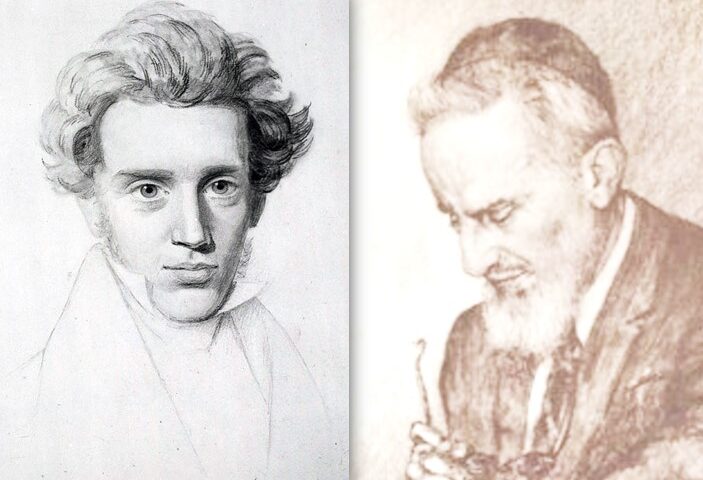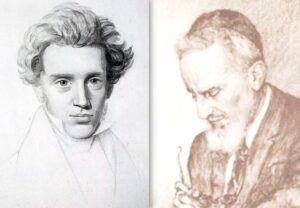Leaps of Faith in Different Directions

Between Kierkegaard and the Rav
Perhaps like many Modern Orthodox Jews, my primary exposure to the Danish philosopher Søren Kierkegaard (1813-1855) came through the writings of Rabbi Joseph B. Soloveitchik. The Rav quoted Kierkegaard in many of his works, most prominently in The Lonely Man of Faith. For instance, I always found the following quote from that essay very moving:
Does the loving bride in the embrace of her beloved ask for proof that he is alive and real? Must the prayerful soul clinging in passionate love and ecstasy to her Beloved demonstrate that He exists? So asked Soren Kierkegaard sarcastically when told that Anselm of Canterbury, the father of the very abstract and complex ontological proof, spent many days in prayer and supplication that he be presented with rational evidence of the existence of God ([Doubleday, 1992], 52).
However, aside from quotes like these, I didn’t know much about Kierkegaard’s life. So when I recently came across a new biography of him, I was interested in reading it.
Clare Carlisle’s Philosopher of the Heart: The Restless Life of Søren Kierkegaard (Allen Lane, 2019) is not a primer on the thought of Kierkegaard, but focuses on his brief, tortuous, and tragic life. Nevertheless, readers of the book benefit from Carlisle’s review of many of Kierkegaard’s major theological insights. One such example can be found in her discussion of Fear and Trembling, which investigates faith through the story of Abraham’s binding of Isaac – the Akedah. Carlisle writes:
Yet Kierkegaard knows as well as anyone that suffering is not merely a philosophical problem – for the task of faith is not to explain suffering, but to live with it. Our most urgent existential questions ask not Why do we suffer? but How should we suffer? (47).
He thinks that attempts at easy religious consolation, which cut too quickly to promises of a happy ending, are like the metaphysical conjuring tricks of theologians who argue that evil has no real existence because it is only the absence of goodness. (48).
 These quotations represent some of the most well-known principles found in the thought of the Rav, in works such as Kol Dodi Dofek, “A Halakhic Approach to Suffering,” and Halakhic Man. This led me to wonder: How did the philosophy of a Danish theologian become so central to the Rav’s thought?
These quotations represent some of the most well-known principles found in the thought of the Rav, in works such as Kol Dodi Dofek, “A Halakhic Approach to Suffering,” and Halakhic Man. This led me to wonder: How did the philosophy of a Danish theologian become so central to the Rav’s thought?
The Akedah plays an important role in the writings of both Kierkegaard and the Rav. Much has been written about how both thinkers deal with the tension between ethics and obedience to the divine command in that episode. But Carlisle’s biography provided me with new insights into the similarities, and more significantly, the contrasts, between the two, and how those contrasts manifest in their philosophical writings.
Kierkegaard is known as the “father of existentialism,” the school of thought that teaches how to live as a singular individual. He was also associated with fideism, which claims that religious belief has to come from faith alone, and remains irrational or incomprehensible. This is the source of his “leap of faith” necessary to become a “knight of faith.” All this aligns well with the Rav’s Lonely Man of Faith, also an individual who needs to deal with the crisis of faith in the modern world.
However, while much of their views of faith overlapped, they came from converse positions. Kierkegaard was opposed to the establishment, particularly the established Danish church. He thought that challenging and criticizing the Church and the State (two institutions linked in 19th century Denmark), and being persecuted for it, should be the goal of the religious person. He felt that by his time, the Church had deviated from its mission and become too set in its ways. Carlisle spends many pages describing such battles and their consequences on Kierkegaard.
The Rav had the opposite concern. He was interested in preserving the established structures of Judaism, which were eroding through the confrontation with modernity. Since the beginning of the Enlightenment, rationalism was used as an excuse to abandon traditional Judaism. For the Rav, the “leap of faith,” which could sever the connection between rationalism and faith, could now preserve religion in modern times. To maintain halakhic commitments, one does not need to understand the “why,” only the “how,” and that allows full commitment to God.
Beyond the public square, the real contribution of Carlise’s biography is its window into Kierkegaard’s private life. The most dramatic element of the book is the description of how he broke off an engagement with his young fiancée, Regine Olsen. His exact motivations are unclear, but it does seem that he could not reconcile his devotion to God with his commitment to her, in what Carlisle calls “dubious sacrificial heroism.” Regine was devastated by his actions, but eventually married another man. Throughout the rest of his life, Kierkegaard rationalized his decision, and (in my opinion, cruelly) continued to reach out to Regine.
Kierkegaard’s interpretation of the Akedah sheds light on his interactions with Regine. As Carlisle writes, “he did not, like Abraham, need a knife … he feels that he has sacrificed a life with Regine” (8).
For Kierkegaard, Abraham’s leap of faith entailed both the willingness to give up Isaac and the belief that they would remain together. This seems to have been his approach to Regine as well – even after he ended the engagement, he didn’t truly believe their relationship was over. He persisted in contacting her, and even wore her returned engagement ring on his finger until the day he died. Carlisle describes it this way: “He hopes in some way to remain true to Regine despite breaking the engagement. That might seem impossible, but Abraham’s faith seemed impossible too” (44).
The self-centered, even immature, behavior of Kierkegaard is diametrically opposed to that of the Rav. The Rav’s familiarity with Kierkegaard’s writings likely indicates some familiarity with his biography as well. I think it is remarkably significant that in his most Kierkegaardian work, The Lonely Man of Faith, the Rav commenced with a dedication to his wife: “To Tonya – A woman of great courage, sublime dignity, total commitment, and uncompromising truthfulness.”
As is well-known the Rav’s covenantal relationship with his wife could not have been more different than Kierkegaard’s treatment of Regine. Their relationship, as highlighted in the dedication, was one of “total commitment.” In the essay itself, the Rav shows that dedication to God does not preclude a successful relationship. In fact, it is essential for it:
If God had not joined the community of Adam and Eve, they would never have been able and would have never cared to make the paradoxical leap over the gap, indeed abyss, separating two individuals whose personal experiential messages are written in a private code undecipherable by anyone else… Only when God emerged from the transcendent darkness of He-anonymity into the illumined spaces of community knowability and charged man with an ethical and moral mission, did Adam absconditus and Eve abscondita, while revealing themselves to God in prayer and in unqualified commitment, also reveal themselves to each other in sympathy and love on the one hand and in common action on the other. Thus, the final objective of the human quest for redemption was attained: the individual felt relieved from loneliness and isolation (66-67).
A marriage tied to the divine covenant can overcome that “leap,” and the Lonely Man of Faith is not quite as lonely.1
But what of the moving quote from Kierkegaard, which spoke of the “loving bride in the embrace of her beloved”? How can that be reconciled with Kierkegaard’s abandonment of his bride? This turns out to be an artful paraphrase of the Rav. In Kierkegaard’s original journal entry, there is no mention of a bride, only the criticism of Anselm.
Like many of his readers, I was introduced to Kierkegaard via the Rav. After reading Carlisle’s biography, I now understand much better how the Rav was able to filter for us the important messages about faith that Kierkegaard had to offer, and set aside the distasteful ideas that run in contrast to the Jewish understanding of commitment and covenant.
David Curwin writes about the origins of Hebrew words on his Balashon Blog, and about Jewish thought in TRADITION and elsewhere.
- In a footnote (107), the Rav directly criticizes Kierkegaard for insisting that “faith supersedes the majestic posture of man,” which is “unacceptable … to the Halakhah.” He adds that Kierkegaard “lacked the understanding of the centrality of the act of objectification of the inner movement of faith in a normal and doctrinal postulate system, which forms the very foundation of the Halakhah.” The incompatibility of the “silence and passivity” of “Kierkegaard’s existentialist world” (as the Rav puts it) with the majesty and commitment that Halakhah demands runs in parallel with the same requirements necessary for a successful marriage.
